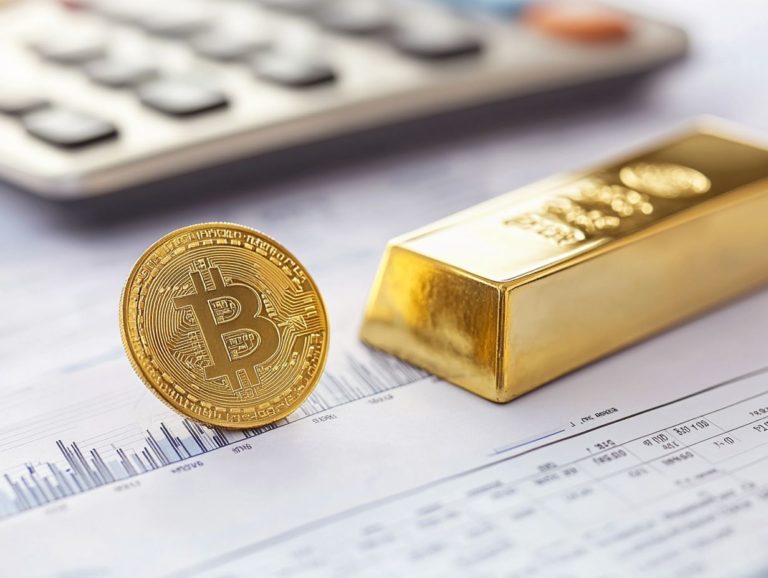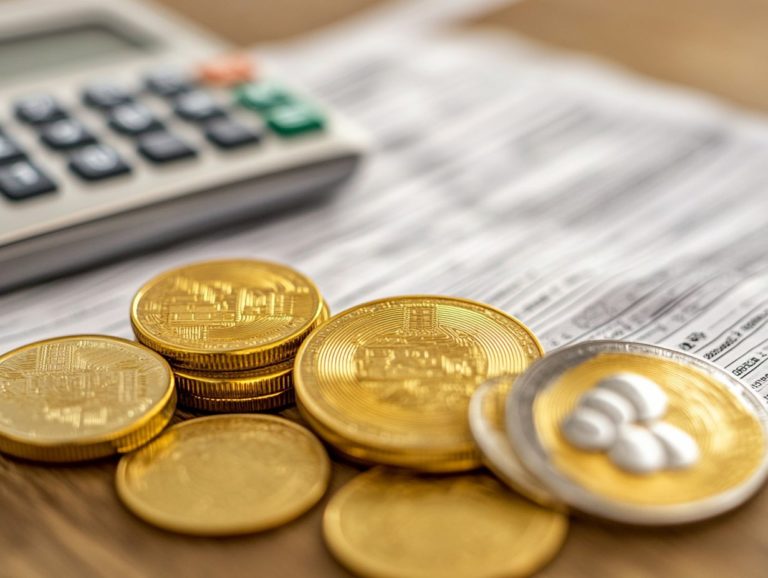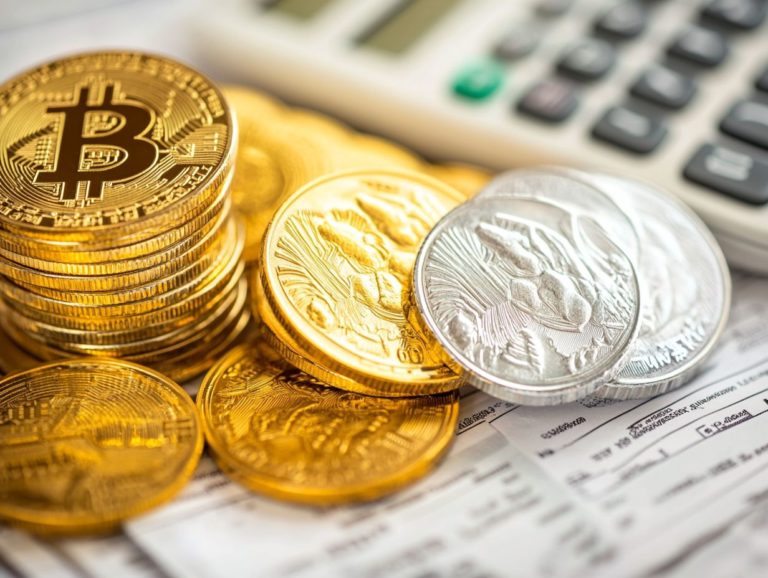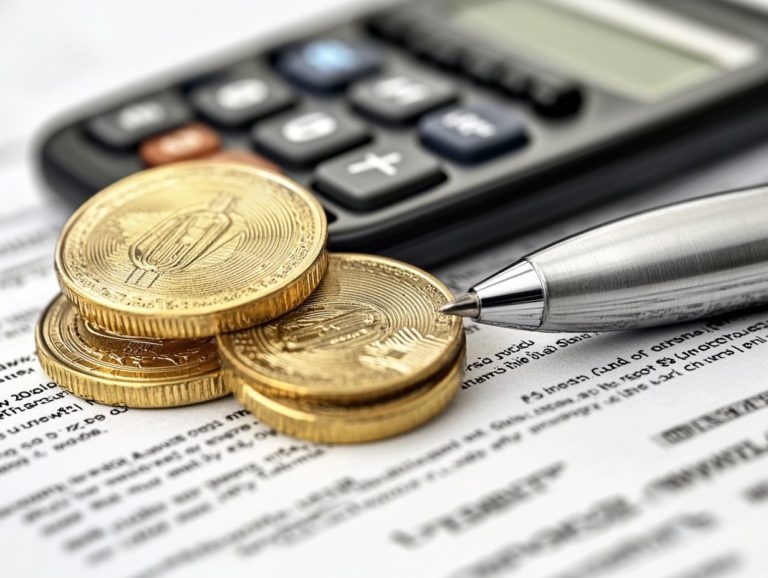Tax Planning for Long-Term Precious Metals Holders
Navigating the realm of precious metals can be a rewarding journey. Yet, it also presents a complex tax landscape that you must understand as a long-term holder.
From capital gains and inheritance taxes to sales tax, each of these factors can significantly impact your investment returns. This guide delves into essential tax planning strategies designed to help you minimize your tax burden.
As you consider holding periods, offsetting gains, or the advantages of retirement accounts, the right approach can truly make a difference. We ll also touch on instances when it s prudent to seek professional advice, ensuring you remain on the right path.
Are you ready to take charge of your financial future? Continue reading to uncover how effective tax planning can greatly benefit you as a long-term precious metals holder.
Contents
- Key Takeaways:
- Types of Taxes on Precious Metals
- Strategies for Minimizing Taxes
- Seeking Professional Advice
- Frequently Asked Questions
- 1. What is tax planning for long-term precious metals holders?
- 2. Why is tax planning important for long-term precious metals holders?
- 3. What are some common tax planning strategies for long-term precious metals holders?
- 4. Can holding precious metals in a retirement account help with tax planning?
- 5. Are there any tax implications for holding precious metals in physical form versus ETFs or other paper investments?
- 6. Should I consult with a tax professional for my long-term precious metals holdings?
Key Takeaways:
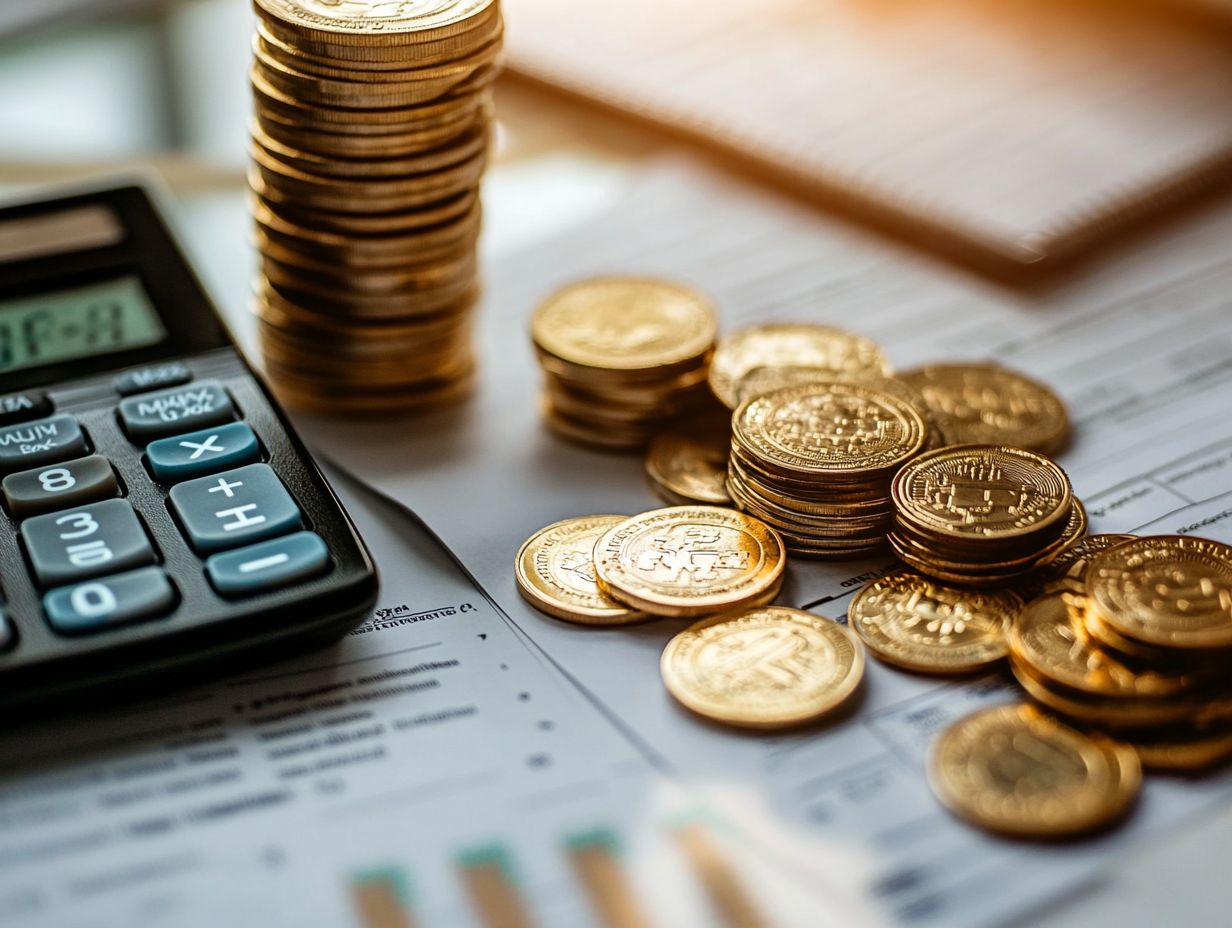
- Proper tax planning is crucial for long-term precious metals holders to minimize tax obligations and maximize profits.
- Precious metals are subject to various taxes, including capital gains, inheritance, and sales tax, which can significantly impact overall returns.
- Strategic measures such as holding periods, offsetting gains with losses, and utilizing retirement accounts can help reduce tax liabilities for long-term precious metals holders.
Why Tax Planning is Important for Long-Term Holders
Tax planning is essential for you as a long-term holder of precious metals like physical gold, silver, and platinum. It serves as your guide through the complex IRS rules and tax implications. Understand how capital gains tax affects your portfolio. This knowledge can greatly influence your financial security and overall investment strategy.
Given the current market conditions and economic uncertainty, adopting a proactive approach to tax planning can lead to substantial benefits, such as lower tax liabilities and better investment returns.
As a long-term holder, it’s vital for you to be aware of other taxes that may apply, including the collectibles tax rate. This tax may apply when selling investments that are considered collectibles. By staying informed about these various tax structures, you can make strategic decisions that maximize your returns while complying with legal requirements.
Having a solid grasp of tax implications not only gives you the power to make informed choices but also enhances your compliance with IRS standards. This protects your investments from potential audits or penalties. A comprehensive understanding of tax planning reinforces a proactive mindset, enabling you to adapt to changes in tax laws and market conditions, thereby securing your financial future.
Types of Taxes on Precious Metals
Investing in precious metals like physical gold, silver, and platinum opens the door to a realm of opportunity. However, it also brings along a variety of tax considerations that can significantly impact your overall returns.
You ll need to navigate capital gains tax, inheritance tax, and sales tax. All of these are key liabilities to keep in mind as you manage your precious metal assets. Each tax carries its own set of regulations and reporting requirements as established by the IRS, making it imperative for you to stay informed about tax compliance.
This knowledge will help you sidestep any unexpected tax consequences.
Capital Gains Tax
Capital gains tax hits you right in the profits when you sell precious metals like gold or silver. It varies based on how long you’ve held them and their market value at the time of sale. As an investor, understanding long-term capital gains is crucial; it can dramatically influence your tax liabilities and shape your overall investment strategy.
By mastering how to calculate your cost basis the original value of an asset for tax purposes and being aware of the tax implications tied to price fluctuations, you can effectively minimize your tax exposure when it comes time to report those gains.
If you hold your investments for over a year, the long-term capital gains tax rate often rewards you with a lower percentage compared to the short-term rates slapped on assets sold within that year. For example, if you buy gold coins for $1,000 and sell them for $1,500 after 18 months, you realize a $500 long-term capital gain. This gain could be taxed at a more favorable rate than if you had sold those coins just six months later.
On the flip side, short-term gains from selling silver rounds within the same year would be taxed at your ordinary income tax rate, which can be significantly higher. This distinction highlights the importance of careful record-keeping and accurate tax reporting to ensure you stay compliant while minimizing your liabilities.
Inheritance Tax
Inheritance tax comes into play when transferring precious metals and other financial securities upon an individual’s passing, significantly impacting your heirs’ financial well-being. Understanding how inheritance tax operates concerning precious metals is essential for effective estate planning and can help you mitigate tax liabilities for your beneficiaries. By ensuring compliance with IRS regulations regarding asset valuation and reporting, you can manage the tax implications efficiently.
If you have a lot of precious metals, it’s time to plan strategically. This means documenting the current value of these assets, considering options like setting up a living trust, and engaging in candid discussions with your heirs about these investments. By exploring available deductions, offsets, and exemptions under the law, you can effectively minimize potential tax obligations, including the tax benefits of investing in precious metals as a hedge.
Consulting with financial advisors who specialize in wills and tax strategies is a wise choice. They can help you maintain compliance while maximizing benefits for your surviving family members, ensuring they receive the intended inheritance with minimal financial strain.
Sales Tax

Sales tax applies when you purchase precious metals, such as gold or silver coins. It varies based on state regulations and IRS classifications. Understanding the intricacies of sales tax in relation to precious metals is crucial for ensuring compliance and making informed investment decisions. Factors like market conditions and purity standards can affect the final cost and tax implications of your transactions.
It’s important to recognize that not all states treat precious metals the same way. Some states classify gold and silver as exempt from sales tax if they meet certain criteria, while others impose standard tax rates that can significantly impact your total investment cost.
Since tax regulations can change frequently, staying informed about local laws and statutes becomes essential. Being aware of these variations not only helps you budget effectively but also protects you from unexpected tax liabilities that could diminish your potential profits from these valuable assets.
Strategies for Minimizing Taxes
Act now to implement these strategies and maximize your savings!
- Leverage long-term capital gains rates
- Offset gains with capital losses
- Utilize tax-advantaged retirement accounts (e.g., gold IRAs, silver IRAs)
By implementing these effective strategies, you can unlock significant savings and enhance your net returns over time. Grasping the nuances of various investment options and their unique tax benefits is crucial for crafting a sophisticated investment strategy that works for you.
Holding Periods and Tax Rates
Holding periods are vital in shaping the tax rates on gains from the sale of precious metals. Generally, the longer you hold, the more favorable the long-term capital gains tax rates become.
It’s essential to understand the tax implications tied to various holding periods. This knowledge helps you make investment choices that align with your overall strategy.
By recognizing the advantages of holding precious metals for an extended time, you can enhance how to keep more of your money and maximize your investment gains.
Short-term capital gains, which apply to assets held for one year or less, are taxed at your ordinary income tax rate. This rate can be significantly higher than the long-term rates, which kick in when assets are held for more than a year.
For instance, if you sell gold bars that you purchased just a few months back, you might face a tax rate as steep as 37%. In contrast, holding those investments longer could mean a tax rate of only 15% or 20%. This dramatic difference can greatly impact your buying and selling decisions.
To refine your approach, consider holding onto precious metals through market fluctuations and timing your sales to be close to that one-year mark. You could also explore tax-advantaged accounts and understand the tax obligations of precious metals. These strategies can dramatically boost your returns while reducing your tax liabilities.
Offsetting Gains with Losses
Offsetting gains with capital losses is a savvy strategy you can leverage to minimize your overall tax liabilities on precious metals investments. By selling underperforming assets to realize losses, you can offset gains and improve your taxable income.
This strategy requires you to keep a close eye on market performance and be proactive in making timely decisions. For example, if you’ve enjoyed significant gains from your gold investments but also own silver assets that have depreciated, selling the underperforming silver can generate capital losses that effectively reduce the taxable amount on your gold gains.
As a result, this approach not only mitigates your immediate tax exposure but also strengthens your portfolio’s resilience by reallocating resources. Applying this tactic effectively can lead to enhanced long-term wealth preservation and optimized asset allocation, making it a cornerstone of astute portfolio management.
Retirement Accounts and Tax Advantages
Utilizing retirement accounts like a gold IRA (a special type of retirement account that allows you to hold gold) or silver IRA can offer you remarkable tax advantages if you re considering adding precious metals to your investment portfolio. These accounts allow for tax-deferred growth, significantly reducing your tax exposure upon withdrawal.
It’s essential to grasp the rules and regulations governing these retirement accounts to fully maximize their benefits.
Specifically, gold and silver IRAs are subject to particular IRS regulations that specify which types of precious metals are eligible for investment. It’s important for you to understand the differences between traditional and Roth retirement accounts; traditional IRAs enable tax-deductible contributions, while Roth options offer the advantage of tax-free withdrawals during retirement.
Incorporating these accounts into your broader investment strategy can be incredibly advantageous. They act as a hedge against inflation and market volatility, thereby enhancing the overall stability of your financial portfolio.
Seeking Professional Advice

Seeking professional advice is a wise move for you as an investor in precious metals, particularly when looking into the complex realm of tax planning and compliance. A qualified tax professional or financial advisor can offer invaluable insights specifically tailored to your investment choices.
They can help you grasp the implications of various tax regulations and guide you toward optimized strategies for managing your precious metals assets. This collaborative approach can significantly enhance your financial outcomes while minimizing potential tax liabilities.
When to Consult with a Tax Professional
Knowing when to consult with a tax professional can profoundly influence your financial security, especially when it comes to precious metals. Major life events, such as selling significant assets or altering investment strategies, often signal the need for expert guidance to ensure you’re compliant with IRS regulations. By recognizing these critical moments, you can take proactive steps to seek advice and enhance your tax planning efforts.
For example, when you decide to buy or sell precious metals, the tax implications can quickly become intricate. It’s essential to have a professional’s insight to navigate potential capital gains, which is the profit you make when selling an asset for more than you paid for it. Life changes, such as receiving an unexpected inheritance, can reshape your financial landscape and lead to pressing questions about tax liabilities and estate planning. Understanding tax regulations for precious metals in retirement accounts can also be crucial during such transitions.
Don’t hesitate to seek expert advice when restructuring your investment portfolio, especially if you re shifting to different asset classes. Engaging with a tax professional means coming prepared with documentation, specific questions about your financial situation, and clear goals for the conversation. This approach fosters a productive consultation that can set you on the path to long-term financial success.
Choosing the Right Advisor
Choosing the right advisor is essential for effectively navigating the intricacies of tax planning for your precious metals investments. It’s important to seek out tax professionals who specialize in this niche and possess a thorough understanding of IRS regulations, investment strategies, and market dynamics. This expertise will ensure that you receive tailored advice that aligns with your financial objectives and optimizes your tax situation.
The selection process deserves your careful attention. Vet potential advisors meticulously to confirm their qualifications and relevance to your specific investment needs. Look for professionals with relevant certifications, a proven track record, and testimonials from clients who were in similar situations.
Ensuring that your tax advisor is well-versed in current tax laws and experienced with understanding your tax obligations for precious metals can significantly enhance the effectiveness of your overall investment strategy.
Take the time to engage in initial consultations to gauge their communication style, approach, and willingness to address your unique concerns. By following these steps, you’ll feel more confident in selecting an advisor who can provide valuable insights and guidance throughout your investment journey.
The Importance of Tax Planning for Long-Term Precious Metals Holders
Tax planning is crucial for you as a long-term holder of precious metals. It significantly impacts the performance of your investment portfolio and your overall financial outcomes. By grasping the complexities of tax compliance and strategically preparing for capital gains tax, inheritance tax, and other liabilities, you can protect your precious metal assets and optimize your returns. This proactive approach not only reduces potential tax consequences but also enhances your overall portfolio management.
As you consider the potential appreciation of precious metals over time, it’s essential to evaluate how taxation can influence your long-term profits. Effective tax planning for precious metals in a diversified portfolio will guide your decisions on when to buy or sell, fostering a more strategic approach to diversification within your portfolio. For instance, leveraging tax-advantaged accounts can yield substantial benefits.
Stay informed about any changes in tax laws that may impact your holdings. This ensures compliance while maximizing your financial security. Ultimately, a comprehensive tax strategy fortifies the overall health of your investment journey.
Frequently Asked Questions
1. What is tax planning for long-term precious metals holders?

Tax planning for long-term precious metals holders refers to strategies and actions taken to minimize the tax burden, or the amount of tax you have to pay, on individuals or organizations who hold precious metals, such as gold, silver, or platinum, for an extended period.
2. Why is tax planning important for long-term precious metals holders?
Tax planning is important for long-term precious metals holders because it can help them save money on taxes, maximize their returns on investment, and protect their wealth.
Ready to take control of your taxes and investments? Contact a professional today!
3. What are some common tax planning strategies for long-term precious metals holders?
Common strategies for long-term precious metals holders include using retirement accounts that provide tax benefits. Timing the sale of your metals can also help minimize capital gains taxes.
4. Can holding precious metals in a retirement account help with tax planning?
Yes! Holding precious metals in a self-directed IRA can offer great tax benefits. This allows for tax-deferred or tax-free growth, which is advantageous for your long-term investment.
5. Are there any tax implications for holding precious metals in physical form versus ETFs or other paper investments?
Yes, there are tax implications to consider. Holding physical metals may involve storage and insurance costs, while ETFs and paper investments can be subject to different tax rates.
6. Should I consult with a tax professional for my long-term precious metals holdings?
You should definitely consult with a tax professional for your tax planning strategies. They can provide personalized advice and help you understand complex tax laws.










